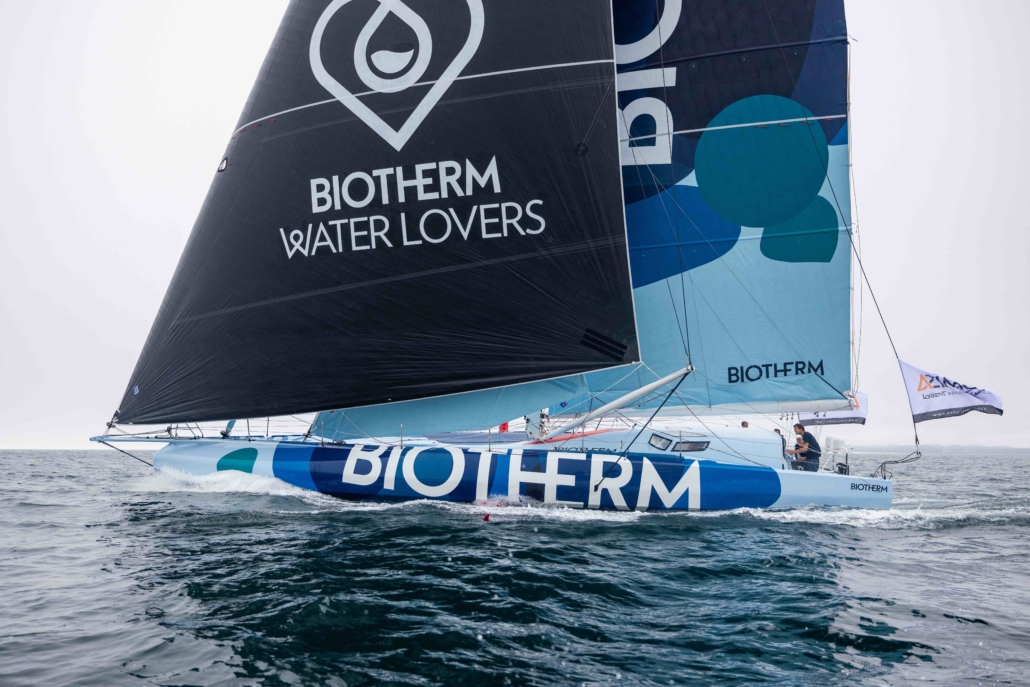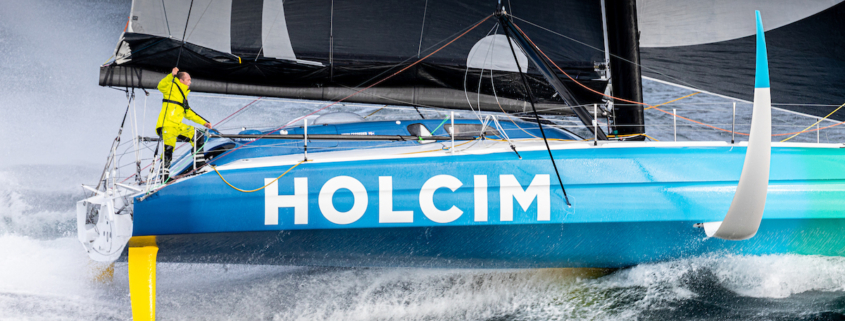The Ocean Race: In Cape Town, the Imocas on the podium are designed by Guillaume Verdier
The spectacular finish of Leg 2 in The Ocean Race demonstrates that you don’t need more than five boats to make a classic, and this one is already showing signs of being just that.After nearly 18 days at sea, it was Kevin Escoffier and the crew of Team Holcim-PRB who pulled out all the stops during the last difficult miles on the way to Cape Town to score their second consecutive victory, after their win in Leg 1.
Remarkably, Paul Meilhat and his crew on Biotherm crossed the line just 16 minutes later, on their way to pipping Charlie Enright and his team on 11th Hour Racing Team Mãlama at the post, by no more than nine minutes.
Once again we are all left wondering how it could be so close – with finishing deltas that would not look out of place on a day-race around the buoys – after more 5,000 nautical miles from the Cape Verde Islands via the Doldrums, the southeast trade winds, and then a long detour into the Southern Ocean around the St Helena High.
With Holcim-PRB now sitting on 10 points, Mãlama in second place on seven and Biotherm a point further back on six, the race is now nicely set-up as we head towards the massive challenge of Leg 3, which scores double points.
Although both Team Malizia and the crew on Guyot Environnement-Team Europe will feel the most hard done-by on this tricky stage – which saw them both confidentally leading – they are by no means out of this. Malizia in particular, could be a real threat in heavy weather in the south on the next leg.
Back in Alicante at the start, there was much discussion about who might win this contest. 11th Hour Racing Team were regarded by many as the favourites, because of their dedicated approach to this event, but Escoffier and Meilhat were seen by many observers as being genuine threats – and so it is proving.
With five more legs to come, including a transatlantic, we still have no idea who is going to win and it was interesting that Sam Goodchild, a key player on Holcim-PRB, was not talking their chances up when they reached the pontoon at Cape Town’s V&A Waterfront.
“Honestly, it was a bit of luck,”said the British skipper who will soon begin his first Vendée Globe campaign. “I’m not going to go on and on about ‘we’re talented, we won,’ because for the last 24 hours, the weather conditions were not at all as expected. I think everyone has been trying like hell to get in front, and Biotherm went in front, 11th Hour Racing Team did last night, and even Team Malizia, who seemed to be very strong today…but we were at the front at the end.”
It is a modest analysis, but it underlines how tight this small fleet is. Goodchild said there is very little to choose between the boats as the crews push them harder and match each other’s improvements. “We were left behind for a little while, but for a good while, we were all about the same speed,” he said. “It was quite impressive and it shows that people are getting to know the IMOCA boat better and better – how to push it – and I think we are learning a lot. All the teams here are learning, the crew members, and in the Southern Ocean, which is great.”
On second-placed Biotherm, the feeling of achievement was palpable. This crew were sailing the most unprepared boat in the race in Leg 1 and had to settle for fourth place in Mindelo, so to move up to runner-up this time is a big confidence-builder.

Damien Seguin was all smiles when he arrived in South Africa. “Super happy,”was his summary when asked how he was feeling. “It’s always nice to finish stages and on top of that, a nice podium, a nice second place. We showed that we know how to use the boat and that we should be taken seriously for the next stages. And then we have had this great welcome at the finish, it’s great.”
Seguin described a long voyage – three days longer than predicted – that tested the stamina of everyone on board. “We did a big lap,” he said. “We struggled in the Doldrums, then went round the St Helena High to finally finish as far south as we could in the leg – that is to say at 47 South, at the edge of the ice zone. We had all the temperatures and we experienced all the emotions.”
And Seguin spoke about a tense final 24 hours, which finished with Meilhat’s crew out-manoeuvring Mãlama within sight of the finish line. “We got back into the match thanks to the weather,”he summarised. “We knew that it was going to hit us from the front, so we came back. We had a superb last night, we managed to get through in front. And then the end was worse than we thought – it was interminable and we wondered which day we would arrive, which month sometimes.”
And Seguin spoke too about the enjoyment he experienced racing an IMOCA with a full crew. “We saw that the boat had potential and I think we had fun sailing her together, despite everything. We managed to maintain a good atmosphere on board between us and that’s very important,”he said.
On Mãlama, third place was hard to take at the end of a leg Enright’s crew knew they could have won. Swiss sailor Justine Mettraux said this finish was reminiscent of Volvo Ocean Race finishes in the past, not least in the last race when eventual winners Dongfeng Race Team (of which she was a part) were overtaken by three boats in the final miles into Newport, Rhode Island.
“For sure this has happened before,” said Mettraux, “but that’s part of the game, that’s part of our sport. Sometimes it is nice for you and sometimes it is nice for others.”
Mettraux reckoned they were unlucky with wind conditions in the final miles, but she also said that tactically the crew could have done better. “When we were leading the pack, we were thinking we could just go straight to Cape Town and we were ahead enough to be able to do it and finally it didn’t happen like this. Maybe we should have controlled our opponents a bit more, maybe we didn’t think that would happen,”she said.
Just like Goodchild, Mettraux enjoyed the IMOCA performance school element in this race. “For sure, it is not often that sailing is this close – that you feel like you’re alongside other boats after 17 days of racing, so that’s really nice,” she said. “I think we all learned a lot more on how to push the boat and how to find the speed. When you have boats around you, you always need to improve, so that has been really interesting for us.”
We asked about the condition of Mãlama after this long Atlantic test. Mettraux says the boat, rig and sails are in excellent shape ahead of Leg 3. “There is nothing major,” she said. “A lot of small things – like we pushed on the boat quite hard on this leg, on the downwind when it was windy – but nothing special.”
With this leg all but done, the focus is quickly shifting to Leg 3 and Mettraux is looking forward to it. “The results in this race are close, we see people go well at different moments, so I think it is going to be interesting,” she said. “There is still a lot to play for. The next leg is the big southern ocean leg which counts for double points, so it will have a big impact on the race, so there is still a lot to happen.”
Goodchild knows the boats will be on the limit during the 13,750-mile marathon to Brazil. “Everyone has little technical problems, but fortunately we are all here in South Africa,” he said. “I hope that on the next leg, everyone will make it to the end too. Everywhere, we want the best boat, the lightest, the strongest, the fastest, and sometimes we go a bit too far. But it’s very reassuring that we’ve only had small problems and I can’t wait for the next stage.”


